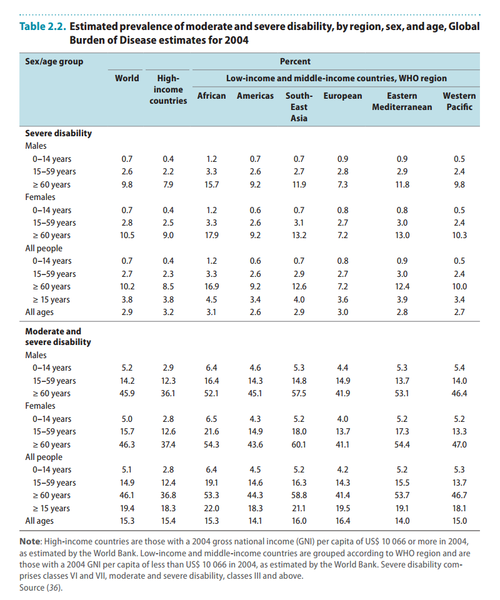Disabilities
According to the World Health Organization, disabilities is:
Disabilities is an umbrella term, covering impairments, activity limitations, and participation restrictions. An impairment is a problem in body function or structure; an activity limitation is a difficulty encountered by an individual in executing a task or action; while a participation restriction is a problem experienced by an individual in involvement in life situations.
Disability is thus not just a health problem. It is a complex phenomenon, reflecting the interaction between features of a person.s body and features of the society in which he or she lives. Overcoming the difficulties faced by people with disabilities requires interventions to remove environmental and social barriers.
People with disabilities have the same health needs as non-disabled people . for immunization, cancer screening etc. They also may experience a narrower margin of health, both because of poverty and social exclusion, and also because they may be vulnerable to secondary conditions, such as pressure sores or urinary tract infections. Evidence suggests that people with disabilities face barriers in accessing the health and rehabilitation services they need in many settings.
Ten facts on disability according to the United Nations:
- Over a billion people live with some form of disability.
- This corresponds to about 15% of the world's population. Between 110-190 million people have very significant difficulties in functioning. Rates of disability are increasing, due to population ageing and the global increase in chronic health conditions.
- Disability disproportionately affects vulnerable populations.
- Lower-income countries have a higher prevalence of disability than higher-income countries. Disability is more common among women, older people and children and adults who are poor.
- People with disabilities often do not receive needed health care.
- Half of disabled people cannot afford health care, compared to a third of non-disabled people. People with disabilities are more than twice as likely to find health-care providers' skills inadequate. Disabled people are four times more likely to report being treated badly and nearly three times more likely to be denied health care.
- Children with disabilities are less likely to attend school than non-disabled children.
- Education completion gaps are found across all age groups in all settings, with the pattern more pronounced in poorer countries. For example, the difference between the percentage of disabled children and the percentage of non-disabled children attending primary school ranges from 10% in India to 60% in Indonesia.
- People with disabilities are more likely to be unemployed than non-disabled people.
- Global data show that employment rates are lower for disabled men (53%) and disabled women (20%) than for non-disabled men (65%) and non-disabled women (30%). In OECD countries, the employment rate of people with disabilities (44%) was slightly over half that for people without disabilities (75%).
- People with disabilities are vulnerable to poverty.
- People with disabilities have worse living conditions.including insufficient food, poor housing, lack of access to safe water and sanitation.than non-disabled people. Because of extra costs such as medical care, assistive devices or personal support, people with disabilities are generally poorer than non-disabled people with similar income.
- Rehabilitation helps to maximize functioning and support independence.
- In many countries rehabilitation services are inadequate. Data from four Southern African countries found that only 26.55% of people received the medical rehabilitation they needed, while only 17.37% received the assistive devices they needed (e.g. wheelchairs, prostheses, hearing aids).
- People with disabilities can live and participate in the community.
- Even in high-income countries, between 20% and 40% of people with disabilities do not generally have their needs met for assistance with everyday activities. In the United States of America, 70% of adults rely on family and friends for assistance with daily activities.
- Disabling barriers can be overcome.
- Governments can:
- promote access to mainstream services;
- invest in specific programmes for people with disabilities;
- adopt a national strategy and plan of action;
- improve staff education, training and recruitment;
- provide adequate funding;
- increase public awareness and understanding on disability;
- strengthen research and data collection; and
- ensure the involvement of people with disabilities in implementing policies and programmes.
- The Convention on the Rights of Persons with Disabilities (CRPD) promotes, protects and ensures the human rights for all people with disabilities.
- So far, nearly 150 countries and regional integration organizations have signed the Convention, and 100 have ratified it. The WHO/World Bank report provides the best available scientific evidence to improve the health and well-being of people with disabilities in line with the CRPD.
The following image shows Table 2.2 Estimated prevalence of moderate and severe disability, by region, sex, and age, Global Burden of Disease estimates for 2004 from Chapter 2: Disability - a global picture from World Report on Disability of the World Health Organization of the United Nations:
